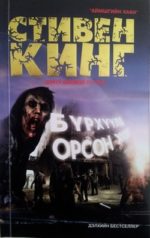Stephen King likes his epics. The Stand was his version of Lord of the Rings and it was already plenty long in 1990 when he added 329 pages to make it his longest book ever, clocking in at 1,153 pages. It was his massive epic about childhood and adulthood coming in at 1,138 pages. And in 2009 he delivered Under the Dome, his third longest book at 1,072 pages. But an epic is about more than mere page count, it’s about an author’s ambitions, and King’s epics deliver as many characters as we can handle, overflowing a town-sized stage, battling The Forces of Absolute Evil in books like ‘Salem’s Lot, The Tommyknockers, Needful Things, Insomnia, Desperation, and The Regulators.
But an interesting thing’s been happening as King gets older: his books have been shrinking. Starting with 1987’s Misery, but especially with 1992’s Gerald’s Game, he’s limited himself more and more to one or two characters in a single location (Dolores Claiborne, The Girl Who Loved Tom Gordon), and when he has given us that epic scale and scope in books like Cell, Lisey’s Story, Duma Key, and 11/22/63 he’s seen the action through the point of view of one or two characters. It’s something he came to late (King didn’t even publish a first person novel until Dolores Claiborne in 1992) but since Insomnia in 1994 he’s approached his epics from a more intimate perspective. But Under the Dome is a throwback, a massive King-sized epic hoagie, dripping with fillings, the size of ‘Salem’s Lot and Needful Things, done the old fashioned way: cramming in absolutely everything he can lay his hands on, and letting it all hang out.
King has occasionally claimed that he originally started Under the Dome in 1972, but I can’t find much evidence to back that up besides this one statement to the New York Times. Most evidence points to the following chronology. In 1976 or 1977, King wrote the opening chapter of a book called Under the Dome, and later lost the pages. In 1981, while on location shooting Creepshow, King took another stab at the story, calling it The Cannibals about a large cast of characters trapped in an upscale apartment building. He wrote 500 pages (you can download the first 122 of them on his website) “before hitting a wall.” In 2007, inspired in part by Ken Follett’s massive historical novels, he took a third run at the material, and this time he wrote the entire book in 15 months. “I was on fire,” he told the New York Times.
 Some folks have pointed out that King’s novel, published in November, 2009 bears a close resemblance to 2007’s The Simpsons Movie in which Springfield is placed under a giant dome, but it also plays with a concept explored in Clifford Simak’s 1965 novel, All Flesh is Grass, about a small town that wakes up one morning to find itself trapped beneath a dome placed by extraterrestrials who want to study their reactions. Then again, The Cannibals was pretty reminiscent of JG Ballard’s 1975 novel, High-Rise, about a luxury high-rise whose residents descend into anarchy and decadence when they seal themselves off from the outside world. It’s also inspired at least in part by Lost, which was pushing peak popularity when King was writing Under the Dome, and the mystery of the Dome with its competing characters trying to decipher weird clues to escape their circumstances, felt more than a little like America’s one-time favorite TV show.
Some folks have pointed out that King’s novel, published in November, 2009 bears a close resemblance to 2007’s The Simpsons Movie in which Springfield is placed under a giant dome, but it also plays with a concept explored in Clifford Simak’s 1965 novel, All Flesh is Grass, about a small town that wakes up one morning to find itself trapped beneath a dome placed by extraterrestrials who want to study their reactions. Then again, The Cannibals was pretty reminiscent of JG Ballard’s 1975 novel, High-Rise, about a luxury high-rise whose residents descend into anarchy and decadence when they seal themselves off from the outside world. It’s also inspired at least in part by Lost, which was pushing peak popularity when King was writing Under the Dome, and the mystery of the Dome with its competing characters trying to decipher weird clues to escape their circumstances, felt more than a little like America’s one-time favorite TV show.
I’ve got a complicated relationship with Under the Dome, because I recapped all three seasons of the TV adaptation and incurred brain damage as a result. Personal injuries aside, Under the Dome is a hell of a book. Does it strain credulity by having a town of 2,000 descend into open warfare after being cut off from the outside world for only a week? Yes. Is its political message broadcast at a volume so loud it can cause permanent hearing loss? YES. Does it demonstrate once again that there is no top that Stephen King can’t vault over one-handed with a cry of “Geronimo!” on his lips? Absolutely. But it also answers the question of why Stephen King has sold 350 million copies of his books: the guy can tell a story.
 Under the Dome starts with Dale Barbie, a noble drifter, leaving the tiny town of Chester’s Mill, Maine after getting jumped in the parking lot of a local bar by a bunch of thugs, including Junior Rennie, son of local bigshot and used car dealer, Big Jim Rennie. This is pretty much exactly how we first met saintly Nick Andros way back in The Stand, and the two characters are virtually identical, save that Barbie can talk. Barbie is a main character who’s as anonymous as they come, with no character flaws or traits to get in the way of our identification with him as he races through the breakneck plot that kicks off in the very first chapter. We’re not even on page ten when an impenetrable dome suddenly surrounds Chester’s Mill, reaching 47,000 feet into the sky and 100 feet underground. It causes a plane crash and bisects a chipmunk, giving the TV show one single moment when it topped the novel.
Under the Dome starts with Dale Barbie, a noble drifter, leaving the tiny town of Chester’s Mill, Maine after getting jumped in the parking lot of a local bar by a bunch of thugs, including Junior Rennie, son of local bigshot and used car dealer, Big Jim Rennie. This is pretty much exactly how we first met saintly Nick Andros way back in The Stand, and the two characters are virtually identical, save that Barbie can talk. Barbie is a main character who’s as anonymous as they come, with no character flaws or traits to get in the way of our identification with him as he races through the breakneck plot that kicks off in the very first chapter. We’re not even on page ten when an impenetrable dome suddenly surrounds Chester’s Mill, reaching 47,000 feet into the sky and 100 feet underground. It causes a plane crash and bisects a chipmunk, giving the TV show one single moment when it topped the novel.
Capitalizing on the town’s sudden isolation from the rest of the world, Big Jim Rennie (who is, of course, a Republican) turns himself into a tiny tyrant, deputizing his insane son, and putting the town under this control. A cardboard cut-out right-winger, Big Jim is not only a big fat hypocrite (the ultimate evil for King) but he bemoans the local bar which he calls a “sinpit”, refuses to use profanity even as he murders his opponents with his bare hands, drives a Hummer, hates President Obama (referring to his middle name “Hussein” as “the terrorist one in the middle”), has a secret porn stash, and bans liquor sales. His churchy exterior conceals the soul of a monster who’s been stealing the town’s propane to power his crystal meth plant hidden inside the Christian radio station he owns. He’s also gotten the local hellfire and brimstone preacher, Lester Coggins, to help him with his meth business. The Rev. Coggins is so twisted and perverse he commits crimes, quivering with an almost-sexual arousal, then flagellates himself for his sins. These are not subtle characters.
 But subtle is not on the menu. We first meet Junior Rennie, Big Jim’s son, on page 19, delivering a whiny, self-pitying inner monologue, the sun giving him a headache. Three pages later, he’s calling his girlfriend’s vagina her “goddam itchy breeding-farm”, biting through his own tongue, and bashing her brains out on the floor. Eighty pages later he murders Dodee, her best friend. Two hundred pages later, he’s having sex with their corpses, and there’s still 800 pages to go. Barbie, Julia Shumway, the local reporter, and their other allies are bland and colorless compared to Junior Rennie, Big Jim, the Rev. Coggins, and the rest of the book’s bad guys, making it apparent that while King may hate these villains and what they represent, they inspire his best writing in a way his heroes don’t. And it’s not just the bad guys who are turned up to 11. King’s writing style is in full-on “Heeeere’s Johnny!” Jack Nicholson mode, as loud and blaring as an axe smashing through a bathroom door.
But subtle is not on the menu. We first meet Junior Rennie, Big Jim’s son, on page 19, delivering a whiny, self-pitying inner monologue, the sun giving him a headache. Three pages later, he’s calling his girlfriend’s vagina her “goddam itchy breeding-farm”, biting through his own tongue, and bashing her brains out on the floor. Eighty pages later he murders Dodee, her best friend. Two hundred pages later, he’s having sex with their corpses, and there’s still 800 pages to go. Barbie, Julia Shumway, the local reporter, and their other allies are bland and colorless compared to Junior Rennie, Big Jim, the Rev. Coggins, and the rest of the book’s bad guys, making it apparent that while King may hate these villains and what they represent, they inspire his best writing in a way his heroes don’t. And it’s not just the bad guys who are turned up to 11. King’s writing style is in full-on “Heeeere’s Johnny!” Jack Nicholson mode, as loud and blaring as an axe smashing through a bathroom door.
“Suddenly he was swept by horripilation. The goosebumps swept up from his ankles all the way to the nape of his neck, where the hairs stirred and tried to lift. His balls tingled like tuning forks, and for a moment there was a sour metallic taste in his mouth.”
 Musical balls aside, some of these ideas were there from the beginning. The Cannibals featured a blue collar, alpha male, NRA member named Pulaski who calls everyone “babycakes” and stockpiles guns in his apartment, including an uzi. And there’s a simpering, god-fearing, overweight, overly-religious woman with an “utterly closed mind” who seems to be on the verge of a nervous breakdown. Both of them appear marked to develop into villains later in the book. But despite its deep roots, Under the Dome is King’s response to the Bush Administration, much in the same way that Cell was his response to 9/11 and the War in Iraq. Starting with an airplane crash (reminiscent of 9/11), Chester’s Mill descends into anarchy under its criminal Republican leadership which uses religion to mask its criminal activities. As they scramble to enrich themselves and conceal their crimes, the leadership and its enemies both ignore dangerous greenhouse gases building up inside the dome that threaten to kill them all. Worried that people might not get the obvious point, King even said, “I want to use the Bush-Cheney dynamic for the people who are the leaders of this town.” Big Jim is clearly Dick Cheney, staying in the shadows, manipulating elected officials with the greatest of ease, and deeply dangerous. Politicians are powerless in the face of his iron will, allowing Big Jim to deal drugs, murder, and steal with total immunity. Just to really drive the point home, Barbie, a war veteran, is prone to saying, “It’s like Iraq all over again.”
Musical balls aside, some of these ideas were there from the beginning. The Cannibals featured a blue collar, alpha male, NRA member named Pulaski who calls everyone “babycakes” and stockpiles guns in his apartment, including an uzi. And there’s a simpering, god-fearing, overweight, overly-religious woman with an “utterly closed mind” who seems to be on the verge of a nervous breakdown. Both of them appear marked to develop into villains later in the book. But despite its deep roots, Under the Dome is King’s response to the Bush Administration, much in the same way that Cell was his response to 9/11 and the War in Iraq. Starting with an airplane crash (reminiscent of 9/11), Chester’s Mill descends into anarchy under its criminal Republican leadership which uses religion to mask its criminal activities. As they scramble to enrich themselves and conceal their crimes, the leadership and its enemies both ignore dangerous greenhouse gases building up inside the dome that threaten to kill them all. Worried that people might not get the obvious point, King even said, “I want to use the Bush-Cheney dynamic for the people who are the leaders of this town.” Big Jim is clearly Dick Cheney, staying in the shadows, manipulating elected officials with the greatest of ease, and deeply dangerous. Politicians are powerless in the face of his iron will, allowing Big Jim to deal drugs, murder, and steal with total immunity. Just to really drive the point home, Barbie, a war veteran, is prone to saying, “It’s like Iraq all over again.”
But cartoonish as the political allegory gets, UtD is studded with massive set pieces that bring every character crashing together with a satisfying boom. Whether it’s the dome’s arrival over Chester’s Mill, an outdoor rally by the townsfolk that descends into farce and then tragedy, Junior Rennie and his debauched police buddies gang raping one of their former friends, a food riot at the local supermarket, or the final firestorm that sweeps through town and consumes all its oxygen, these scenes are the kind of big Thanksgiving feasts that King creates for his readers, tying napkins around their necks, and pushing them up to the groaning table before letting them dig in. They’re deeply satisfying and he pulls them off with a lot of invisible craftsmanship, juggling multiple characters and intense action without ever once dropping the ball.
 Written in short, propulsive chapters of about 20 to 30 pages each, with each chapter divided into three or four subsections that can run as short as a single page, UtD leavens its breakneck pace with a mordant sense of black humor. After one character dies on his John Deere riding mower which keeps chugging along, King writes, “Nothing, you know, runs like a Deere.” The ending feels like a let-down as we discover that the Dome was put in place by punky little alien kids who were goofing around with their parents’ technology. When they learn that the ants on their ant farm are actually getting hurt by their game, they shut it down immediately. It’s a letdown, but after the massive table we’ve gorged ourselves at, anything less than Junior Rennie crater-humping the Moon until it explodes is going to feel like an anticlimax. This is a long book, but not a repetitive one, and it rarely spins its wheels. After all, King has to push civic society to the breaking point and beyond in just seven days. It took the Bush Administration at least a couple of years to do the same.
Written in short, propulsive chapters of about 20 to 30 pages each, with each chapter divided into three or four subsections that can run as short as a single page, UtD leavens its breakneck pace with a mordant sense of black humor. After one character dies on his John Deere riding mower which keeps chugging along, King writes, “Nothing, you know, runs like a Deere.” The ending feels like a let-down as we discover that the Dome was put in place by punky little alien kids who were goofing around with their parents’ technology. When they learn that the ants on their ant farm are actually getting hurt by their game, they shut it down immediately. It’s a letdown, but after the massive table we’ve gorged ourselves at, anything less than Junior Rennie crater-humping the Moon until it explodes is going to feel like an anticlimax. This is a long book, but not a repetitive one, and it rarely spins its wheels. After all, King has to push civic society to the breaking point and beyond in just seven days. It took the Bush Administration at least a couple of years to do the same.
 Grady Hendrix has written for publications ranging from Playboy to World Literature Today; his previous novel was Horrorstör, about a haunted IKEA, and his latest novel, My Best Friend’s Exorcism, is basically Beaches meets The Exorcist.
Grady Hendrix has written for publications ranging from Playboy to World Literature Today; his previous novel was Horrorstör, about a haunted IKEA, and his latest novel, My Best Friend’s Exorcism, is basically Beaches meets The Exorcist.










